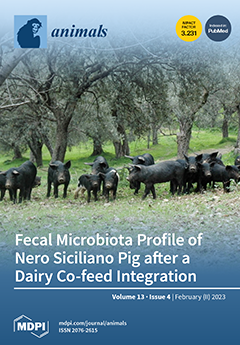The objective of this experiment was to evaluate the impact of maize co-ensiling with increasing percentages of MOL forage on the kinetics of biogas, methane (CH
4), carbon monoxide (CO) and hydrogen sulfide (H
2S) production, as well as the characteristics of ruminal fermentation and CH
4 conversion efficiency, using steers (STI) and sheep (SHI) as inoculum sources. With the STI, the inclusion of MOL reduced (linear:
p ≤ 0.0199; quadratic:
p ≤ 0.0267) biogas production (mL g
−1 DM incubated and degraded), CH
4 (mL g
−1 DM degraded), CO (mL g
−1 DM degraded), and H
2S (mL g
−1 DM incubated and degraded), without affecting (
p > 0.05) the parameters (
b = asymptotic gas,
c = rate of gas production and
Lag = initial delay time before gas production) of CH
4 and H
2S, and the proportion and production of CH
4 per kg of dry matter (DM). In addition, with this inoculum, pH, and dry matter degradation (DMD) increased (linear:
p ≤ 0.0060), and although short-chain fatty acids (SCFA) and metabolizable energy (ME) decreased (linear:
p < 0.0001; quadratic:
p ≤ 0.0015), this did not affect (
p > 0.05) the CH
4 conversion efficiency. Meanwhile, with the SHI, the inclusion of MOL only decreased (linear:
p ≤ 0.0206; quadratic:
p ≤ 0.0003) biogas per dry matter (DM) degraded and increased (linear:
p ≤ 0.0293; quadratic:
p ≤ 0.0325) biogas per DM incubated, as well as the production (mL g
−1 DM incubated and degraded and g
−1 kg DM) and proportion of CH
4, and CO per DM incubated and degraded. In addition, it did not impact (
p > 0.05) on the CH
4 and H
2S parameters, and in the H
2S by DM incubated and degraded, and although it increased (linear:
p ≤ 0.0292; quadratic:
p ≤ 0.0325) the DMD, SCFA, and ME, it was inefficient (quadratic:
p ≤ 0.0041) in CH
4 conversion. It is concluded that regardless of the percentage of MOL, the STI presented the highest values in the production of biogas, CH
4, H
2S, DMD, SCFA, and ME, and the lowest pH, so it turned out to be the most efficient in CH
4 conversion, while with the SHI only the highest production of CO and pH was obtained, and the lowest DMD, SCFA, and ME, so it was less efficient compared to STI.
Full article






